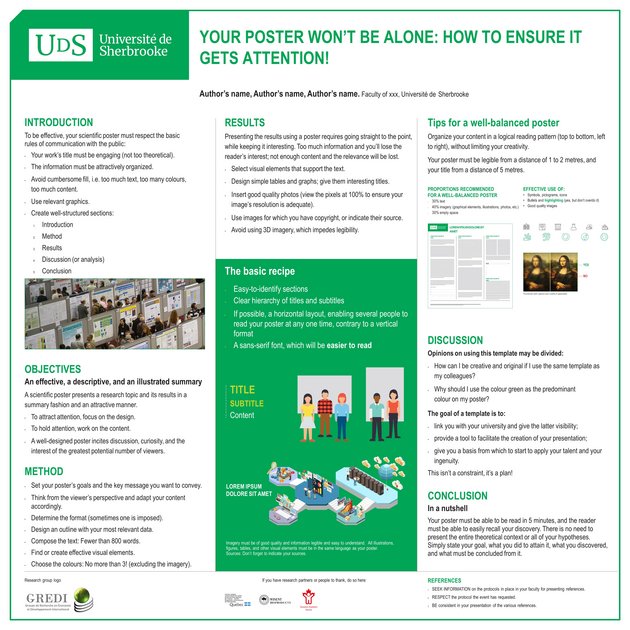Tips for successfully creating your poster
The institutional template to be downloaded contains basic information on the preferred fonts, the various sections that your poster should have, and how to make it stand out while respecting the rules.
The size and all of the elements and sections can be modified. Rely on the guidelines it contains to customize your content and create your poster.
Advice for successfully creating your poster and making it stand out
- Before starting your poster, check the dimensions required by the organizers of the event in which you will be participating.
- If there is no size specified, opt for a horizontal poster: This will make it easier for several people to read it at the same time.
- Choose the main colour (e.g. green) and a maximum of two other colours (excluding colour photos and illustrations). A white background and contrasting colours are recommended for the text (preferably black) and visual elements.
- The institutional template was created to highlight your association with the Université de Sherbrooke. You must retain the institution’s signature image (university logo) as well as the exterior green border.
NOTE: Templates are provided in PPT format. Posters must be formatted to the appropriate size. In PowerPoint: 1- Design tab. 2- Slide size. 3- Custom Slide Size tabs, then enter the sizes you need.
Depending on the field of study, the content elements of a scientific poster will vary slightly, but generally speaking, your poster should have the following sections: an introduction, objectives, a method, results, discussion, a conclusion, and references. These sections should allow the reader to determine:
- The issue you are addressing;
- What you wanted to find, solve, demonstrate;
- From what perspectives you tackled the issue;
- What you experimented with, tested, measured;
- What you discovered;
- What can be concluded and what requires more in-depth investigation.
Depending on the type of event, your poster could be consulted both by novices, who should be able to grasp the general ideas of your main findings, as well as by people with more expertise, who should obtain enough information to engage you in a discussion.
Participants will only have a few minutes to read your poster. Focus on what is essential, keep it simple, and ensure that your main findings are highlighted. Keep less vital explanatory aspects for discussion with the public.

